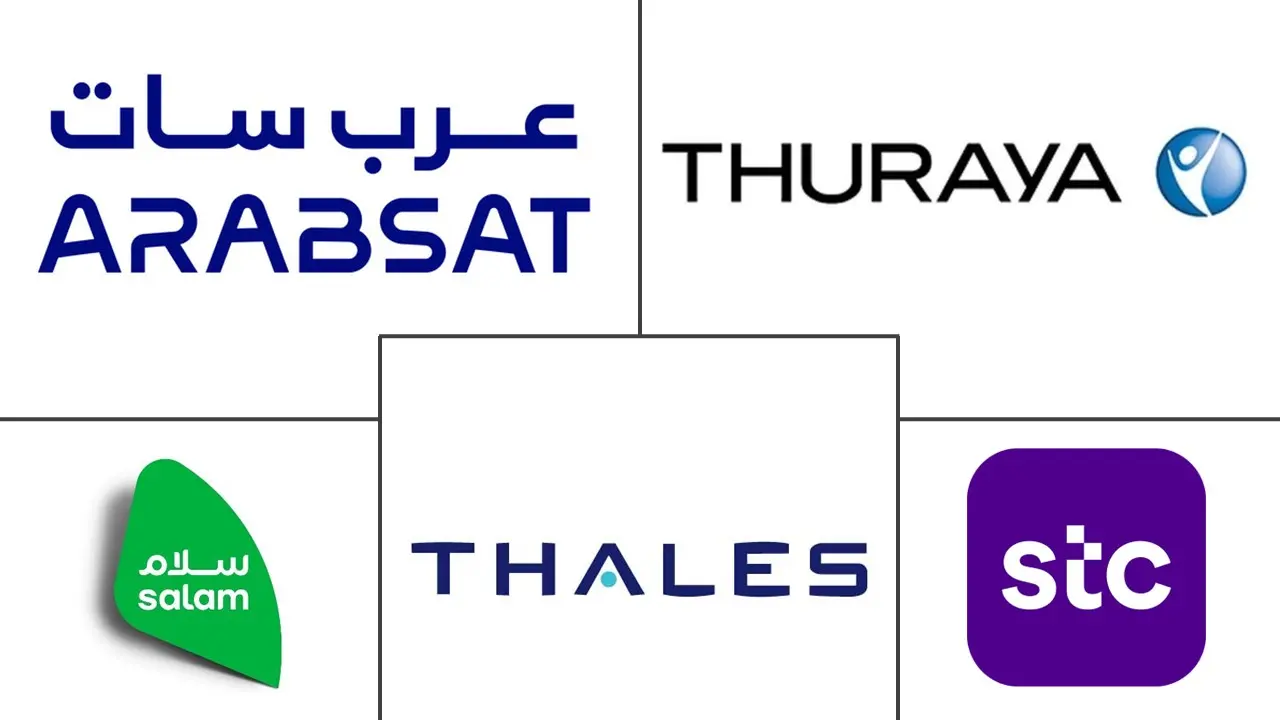KSA Satellite Communications Market Size and Share
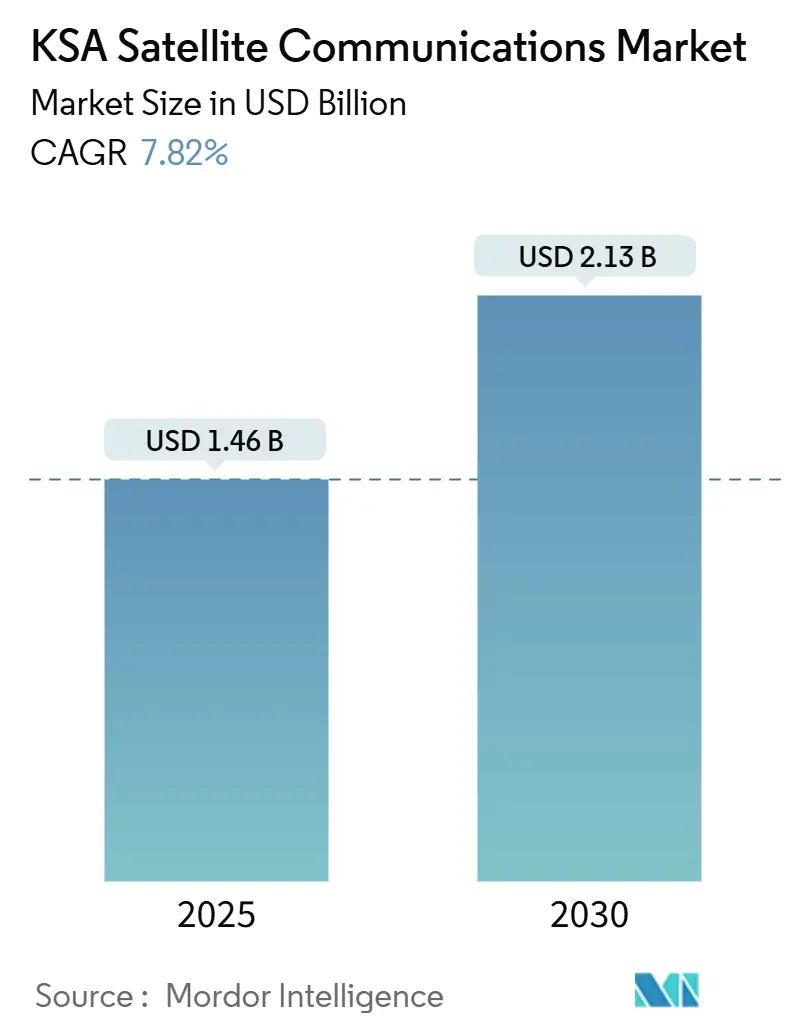
KSA Satellite Communications Market Analysis by Mordor Intelligence
The KSA Satellite Communications Market size is estimated at USD 1.46 billion in 2025, and is expected to reach USD 2.13 billion by 2030, at a CAGR of 7.82% during the forecast period (2025-2030).
Rising public-sector capital outlays, streamlined spectrum awards, and Vision 2030’s mandate to extend next-generation connectivity into every industry underpin this expansion. Substantial funding from the Public Investment Fund (PIF) has already positioned Neo Space Group as the national champion, while cross-border demand from aviation, maritime and energy operators accelerates uptake of multi-orbit capacity. Market participants view managed services as a pragmatic way to avoid upfront equipment costs; at the same time, Ku- and Ka-band high-throughput satellites (HTS) guarantee the bandwidth density required for 5G backhaul and IoT analytics. Consolidation—exemplified by SES’s purchase of Intelsat—adds pricing power but also raises the bar for cybersecurity, orchestration and service-level guarantees.
Key Report Takeaways
- By technology, VSAT systems led with 38.4% of KSA satellite communication market share in 2024; LEO constellations are projected to grow at 12.6% CAGR through 2030.
- By frequency, Ku-band held 34.7% share of the KSA satellite communication market size in 2024, while Ka-band is expanding at 11.9% CAGR.
- By solution, ground equipment accounted for 61.2% of the KSA satellite communication market size in 2024; managed services register the fastest 10.3% CAGR.
- By platform, land-based systems dominated with 42.5% KSA satellite communication market share in 2024, whereas airborne platforms advance at 9.8% CAGR.
- By end user, defense and government represented 36.1% of demand in 2024, but oil, gas and energy post the highest 8.7% CAGR.
KSA Satellite Communications Market Trends and Insights
Drivers Impact Analysis
| Driver | (~) % Impact on CAGR Forecast | Geographic Relevance | Impact Timeline |
|---|---|---|---|
| Ubiquitous broadband demand | +1.8% | Rural districts & Red Sea routes | Medium term (2-4 years) |
| Vision 2030 & KSA Space Strategy capital spending | +2.1% | NEOM, Red Sea Project, Qiddiya | Long term (≥ 4 years) |
| Digital-first oil & maritime IoT backhaul | +1.4% | Eastern Province oilfields & maritime corridors | Short term (≤ 2 years) |
| Planned sovereign LEO constellation | +1.2% | Nationwide, with regional spill-over | Long term (≥ 4 years) |
| Mandatory redundancy after Gulf cable outages | +0.9% | Critical infrastructure sites | Short term (≤ 2 years) |
| HAPS gateways requiring satellite backhaul | +0.4% | Major urban zones | Medium term (2-4 years) |
| Source: Mordor Intelligence | |||
Government Investment Under Vision 2030 and KSA Space Strategy
The USD 500 billion Vision 2030 program allocates sustained capital to space assets, including PIF’s USD 270 million domestic satellite-manufacturing line and Neo Space Group’s multi-orbit roadmap. Complementing expenditure, the Communications, Space & Technology Commission (CST) has opened multiyear spectrum blocks for Ka- and Ku-band and introduced the USD 28 million SpaceUp Competition to spur downstream analytics. These policies de-risk commercial deployments, grow a local supply chain and embed sustainability standards in procurement specifications. [1]Saudi Press Agency, “SpaceUp Competition Announced with USD 28 Million Awards,” spa.gov.sa
Digital-First Shift in Oil and Maritime IoT Backhaul
Saudi Aramco’s memorandum with SES to deploy MEO connectivity for 5G backhaul exemplifies the transition from legacy VSAT to hybrid GEO-MEO-LEO models. Low-latency links now enable real-time pipeline diagnostics and autonomous drilling, while Red Sea shipping operators adopt satellite-enabled vessel tracking to meet just-in-time logistics targets. Edge computing nodes positioned at offshore rigs exploit satellite redundancy when fiber links are unviable, driving recurring bandwidth purchases from regional fleet operators. [2]Advanced Television, “Aramco and SES Sign MoU for MEO 5G Backhaul,” advanced-television.com
Increased Demand for Ubiquitous Broadband Connectivity
Roughly 15.7% of Saudi residents live outside dense fiber footprints, so policymakers treat satellite backhaul as a prerequisite for 5G coverage parity. STC Group’s partnership with Tonomus at NEOM integrates LEO capacity for 10 Gbps site links, while CST’s National Spectrum Strategy grants licensing priority to rural broadband proposals. Consumer surveys indicate 71% of airline passengers prefer in-flight streaming, a demand met only by contiguous satellite beams across Saudi airspace.[3]StockTitan, “Survey Shows 71% of Passengers Prioritize Streaming In-Flight,” stocktitan.com
Planned Saudi Sovereign LEO Constellation (Neo Space Group)
By acquiring Airbus’s UP42 platform, Neo Space Group secures data-analytics IP essential for a wholly-owned LEO fleet that will provide connectivity, Earth-observation and PNT services. Early commercial validation came via Thai Airways’ in-flight contract, reinforcing export potential. The constellation mitigates geopolitical vulnerability exposed when foreign operators experienced service curbs during regional tensions, while CST’s debris-mitigation rules favor modern small-sat buses.
Restraints Impact Analysis
| Restraint | (~) % Impact on CAGR Forecast | Geographic Relevance | Impact Timeline |
|---|---|---|---|
| Regulatory & spectrum-allocation delays | –1.1% | Kingdom-wide, cross-border filings | Short term (≤ 2 years) |
| Fiber & 5G terrestrial roll-out competition | –1.6% | Urban and industrial corridors | Medium term (2-4 years) |
| Import duties on ground-equipment parts | –0.7% | Nationwide | Short term (≤ 2 years) |
| Shortage of Ka/Ku RF installation talent | –0.5% | Technical hubs | Medium term (2-4 years) |
| Source: Mordor Intelligence | |||
Regulatory and Spectrum-Allocation Delays
CST’s integration of space oversight has lengthened approval queues, especially for LEO filings that require ITU coordination. Foreign-ownership limits of 60% mean overseas operators must form joint ventures, extending deal cycles. Dual compliance with CST and SASO adds 6-12 months to equipment roll-outs, prompting some enterprises to defer projects.
Competition from Fiber and 5G Terrestrial Roll-Outs
Saudi Telecom Company and PIF-backed towerco TAWAL are laying high-capacity fiber and building 30,000 macro sites, eroding satellite’s addressable market in densely populated corridors. Fixed-wireless access already covers one-fifth of broadband subscriptions, and new submarine cables to Egypt assure international redundancy. Consequently, satellite solutions must now emphasize mobility, resiliency and niche remote-area value rather than simple broadband substitution.
Segment Analysis
By Technology Type: LEO Disruption Accelerates Multi-Orbit Integration
VSAT systems retained 38.4% of KSA satellite communication market share in 2024, reflecting entrenched deployments in defense networks and oilfield SCADA sites. The KSA satellite communication market size for VSAT still grows, yet LEO constellations outpace at 12.6% CAGR as Starlink and Neo Space Group gain aviation and maritime licenses. Notably, SES-Intelsat’s merger unlocks bundled GEO-MEO-LEO contracts that compress total cost of ownership for enterprises seeking latency-sensitive connectivity.
Multi-orbit orchestration software allows service providers to route traffic dynamically, exploiting GEO for broadcast, MEO for mid-latency data and LEO for burst capacity. This capability dovetails with CST’s cybersecurity guidance mandating end-to-end encryption and link diversity, thereby steering contracts toward operators offering integrated architectures.
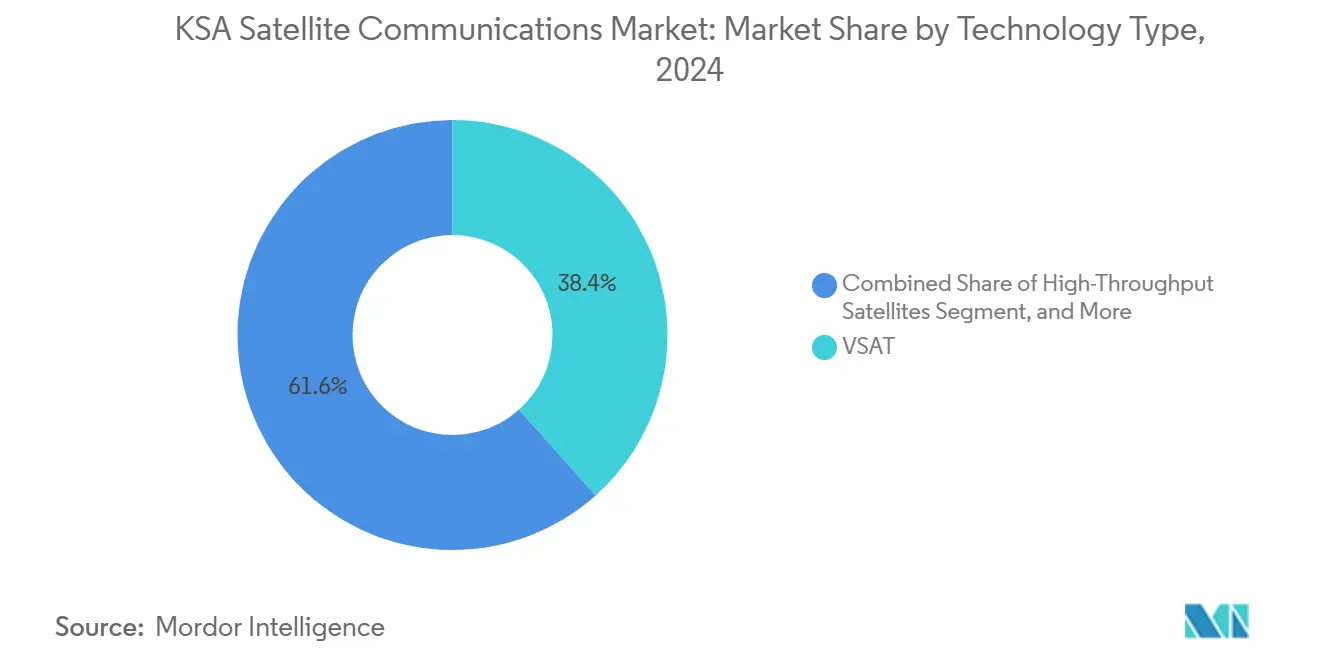
Note: Segment shares of all individual segments available upon report purchase
By Frequency Band: Ka-Band Growth Driven by HTS Adoption
Ku-band preserved 34.7% share of KSA satellite communication market size in 2024, benefiting from field-proven terminals and largescale anchor tenants. However, Ka-band’s 11.9% CAGR mirrors demand for HTS beams to backhaul 5G and enterprise SD-WAN applications. Arabsat’s planned Badr-9 flexible payload will add steerable Ka-band capacity across Saudi Arabia, while CST’s latest allocation round earmarked additional 2 GHz for Ka backhaul.
Technical hurdles—rain fade, tighter pointing—are countered by auto-tracking antennas and adaptive coding, trimming link budgets. Meanwhile, C-band relinquishes terrestrial mobile spectrum, pushing broadcasters toward Ku and Ka. Experimental Q/V-band gateways at KAUST hint at the Kingdom’s long-term spectrum roadmap.
By Solution: Managed Services Growth Reflects OPEX Preference
Ground equipment still commanded 61.2% of the 2024 revenue pool, yet managed services grow 10.3% CAGR as enterprises swap capex for opex. The KSA satellite communication market size tied to managed services accelerates because operators now bundle capacity, cybersecurity and SLA monitoring into subscription tiers.
Neo Space Group’s neXat platform showcases this pivot, offering portal-based orchestration for multi-orbit bandwidth. CST’s stringent vulnerability-assessment rules deter DIY operation, nudging corporates toward fully managed contracts. Hardware vendors in turn reposition as service integrators, wrapping support and firmware upgrades into recurring revenue.
By Platform: Airborne Applications Drive Premium Growth
Land-based nodes retained 42.5% share in 2024, but airborne platforms post a brisk 9.8% CAGR. Riyadh Air’s Viasat deal underscores the revenue uplift obtainable from streaming-grade IFC, while defense orders specify high-throughput links for UAV reconnaissance. The KSA satellite communication market size for airborne links expands as seatback data usage surges and airlines chase ancillary revenues.
Maritime demand remains resilient on Red Sea lanes, where new smart ports mandate AIS data offload and crew welfare Internet. Portable man-pack terminals address special-forces and disaster-relief missions, a niche yet strategic sub-segment.
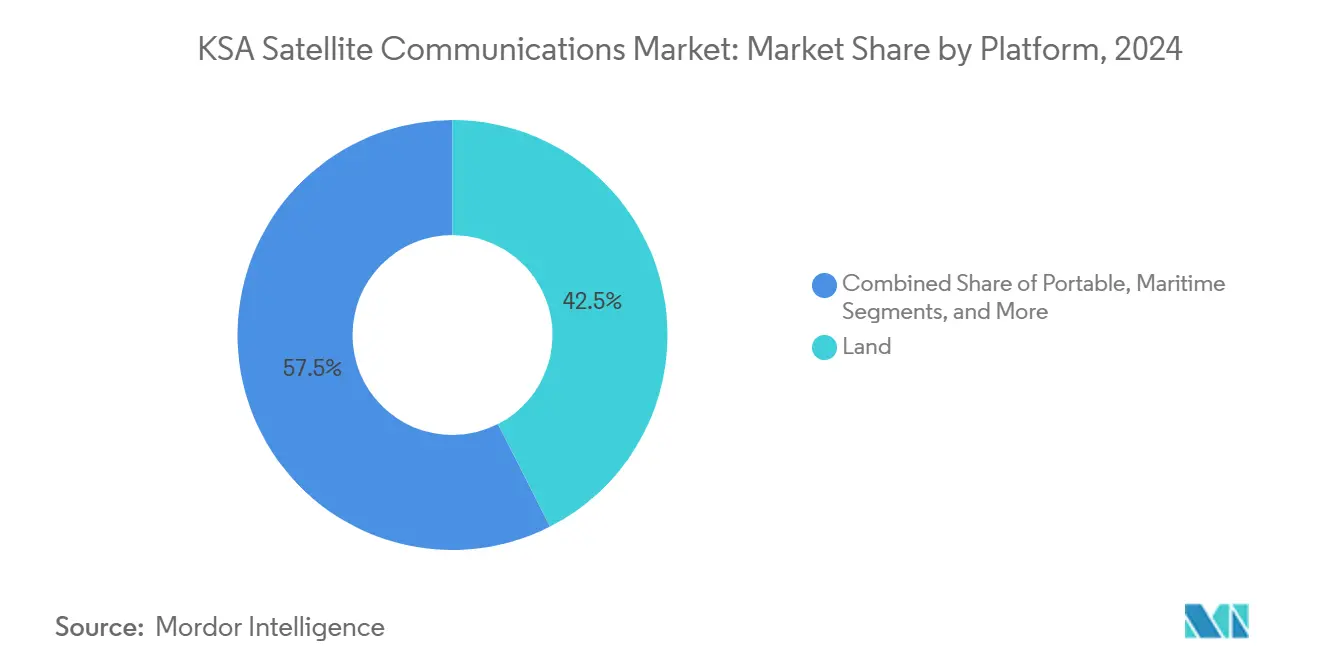
Note: Segment shares of all individual segments available upon report purchase
By End-User Vertical: Energy Sector Digitalization Accelerates Adoption
Defense and government generated 36.1% of 2024 sales, leveraging budgets that rose to USD 78 billion in 2025. Still, oil, gas and energy exhibit the strongest 8.7% CAGR as Aramco deploys IoT sensors, drones and edge analytics requiring sub-second links. The KSA satellite communication market share of energy clients is set to widen as hydrogen refineries and carbon-capture sites come online in remote deserts.
Media, finance and NGOs maintain steady requirements, primarily for business-continuity circuits. Mega-projects such as NEOM and Qiddiya onboard multi-orbit packages during construction phases, then pivot to hybrid fiber-satellite models for long-term operations.
Geography Analysis
Domestic revenues dominate because Vision 2030 channels capital toward national infrastructure, and CST policies favor sovereign capacity. Eastern Province oilfields alone host hundreds of VSAT and new MEO terminals, reflecting Aramco’s 24/7 monitoring mandates. The KSA satellite communication market size attached to Red Sea maritime corridors grows in tandem with throughput-hungry shipping platforms.
Mega-projects NEOM, Red Sea Project and Qiddiya create green-field demand clusters where LEO backhaul assures high-bit-rate links before fiber trenching is complete. Operators leverage these projects as test-beds for AI-based beam steering and spectrum sharing.
Regional expansion into GCC neighbors offers scale, with Arabsat and Neo Space Group exploiting orbital slots that blanket North Africa and West Asia. Cross-border aviation corridors linking Europe and Asia generate transient yet lucrative traffic, especially after Starlink obtained Saudi airspace clearances.
Competitive Landscape
Arabsat (revenues > USD 200 million in 2023) and Saudi Telecom Company (with 36.66% Arabsat ownership) headline incumbents, but the 2025 SES-Intelsat merger reshapes bargaining power by pooling over 100 GEO and 26 MEO satellites. Neo Space Group, bankrolled by PIF, accelerates toward sovereign LEO while acquiring Airbus’s UP42 analytics arm to widen its value chain.
Starlink’s May 2025 license for aviation and maritime disrupts price premiums on mobile services, pressuring incumbents to refresh tariffs. Thuraya’s Thuraya-4 launch expands IoT coverage in isolated oilfields and fisheries, while Eutelsat OneWeb’s Tabuk gateway anchors LEO coverage across the Levant.
Competitive edge now hinges on integrated service catalogs, cyber-hardening certification, and vertical-specific SLAs. The top five players hold roughly 58% of revenue, placing the market in the upper-mid concentration bracket.
KSA Satellite Communications Industry Leaders
-
Arab Satellite Communications Organization
-
Saudi Telecom Company (STC)
-
Thales Group
-
Salam (Integrated Telecom Company)
-
Thuraya Telecommunications Company
- *Disclaimer: Major Players sorted in no particular order
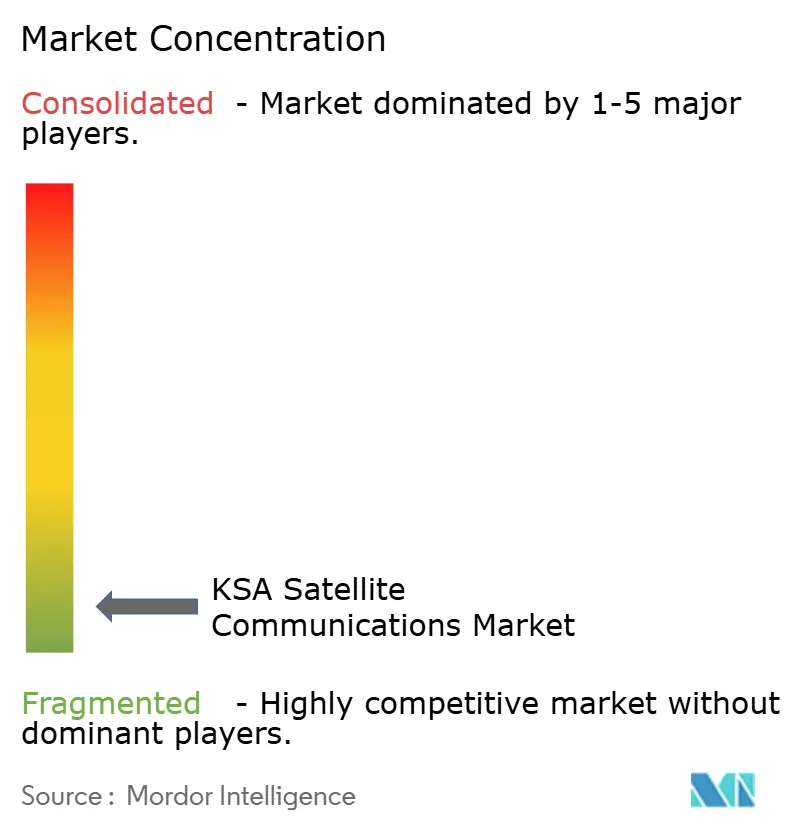
Recent Industry Developments
- July 2025: SES closed a USD 3.1 billion deal to acquire Intelsat, creating a global multi-orbit platform.
- May 2025: Starlink secured aviation and maritime licenses to operate in the Kingdom.
- April 2025: Riyadh Air picked Viasat for gate-to-gate Ka-band IFC on its 787 fleet.
- March 2025: Arabsat debuted neXat managed services, moving beyond pure capacity leasing.
KSA Satellite Communications Market Report Scope
Satellite communication employs satellites as relay stations to facilitate long-distance communication between ground stations and user terminals. Orbiting the Earth, satellites receive signals (uplink), amplify them, and then retransmit (downlink) to other ground stations. This technology surpasses the range limitations of traditional communication methods like ground wave and skywave.
The market is defined by the revenue generated from types such as ground equipment and services used in various end-user applications across KSA.
The KSA satellite communications market is segmented by technology type (VSAT (very small aperture terminal), high-throughput satellites (HTS), low earth orbit (LEO) and medium earth orbit (Meo) constellationsdirect-to-home (DTH) broadcasting), frequency band (l-band, c-band, ku-band, ka-band, others ), solution (ground equipment, services), platform (portable, land, maritime, and airborne), and end user vertical (maritime, defense & government, enterprises, media & entertainment, and other end user verticals). The report offers market forecasts and size in value (USD) for all the above segments.
| VSAT (Very Small Aperture Terminal) |
| High-Throughput Satellites (HTS) |
| Low-Earth-Orbit (LEO) Constellations |
| Medium-Earth-Orbit (MEO) Constellations |
| Direct-to-Home (DTH) Broadcasting |
| L-band |
| C-band |
| Ku-band |
| Ka-band |
| Q/V and Optical (Others) |
| Ground Equipment | Antennas and Terminals |
| Gateways and Hubs | |
| Modems and Routers | |
| Managed Services | Capacity Leasing |
| Support and Maintenance |
| Portable / Man-pack |
| Land |
| Maritime |
| Airborne (Commercial and Defense) |
| Maritime |
| Defense and Government |
| Oil, Gas and Energy Enterprises |
| Media and Entertainment |
| Financial and Corporate Enterprises |
| Other Verticals (Education, Healthcare, NGOs) |
| By Technology Type | VSAT (Very Small Aperture Terminal) | |
| High-Throughput Satellites (HTS) | ||
| Low-Earth-Orbit (LEO) Constellations | ||
| Medium-Earth-Orbit (MEO) Constellations | ||
| Direct-to-Home (DTH) Broadcasting | ||
| By Frequency Band | L-band | |
| C-band | ||
| Ku-band | ||
| Ka-band | ||
| Q/V and Optical (Others) | ||
| By Solution | Ground Equipment | Antennas and Terminals |
| Gateways and Hubs | ||
| Modems and Routers | ||
| Managed Services | Capacity Leasing | |
| Support and Maintenance | ||
| By Platform | Portable / Man-pack | |
| Land | ||
| Maritime | ||
| Airborne (Commercial and Defense) | ||
| By End-user Vertical | Maritime | |
| Defense and Government | ||
| Oil, Gas and Energy Enterprises | ||
| Media and Entertainment | ||
| Financial and Corporate Enterprises | ||
| Other Verticals (Education, Healthcare, NGOs) | ||
Key Questions Answered in the Report
How large is the KSA satellite communication market in 2025?
It reached USD 1.46 billion in 2025 and is projected to grow at 7.82% CAGR through 2030.
Which technology leads adoption across Saudi Arabia?
VSAT remains the largest with 38.4% market share, but LEO constellations are expanding fastest at 12.6% CAGR.
What drives Ka-band growth in the Kingdom?
High-throughput satellite beams for 5G backhaul and enterprise SD-WAN push Ka-band to an 11.9% CAGR through 2030.
Which vertical shows the fastest bandwidth demand?
Oil, gas and energy register the highest 8.7% CAGR due to IoT sensors and autonomous drilling.
How will Starlink’s entry affect local operators?
The May 2025 license intensifies competition for aviation and maritime clients, pressuring incumbents to refine pricing and multi-orbit offerings.
What role does Vision 2030 play in satellite uptake?
Vision 2030 funds domestic manufacturing, mega-project connectivity and regulatory easing, lifting the market’s overall CAGR by an estimated +2.1 percentage points.
Page last updated on:
